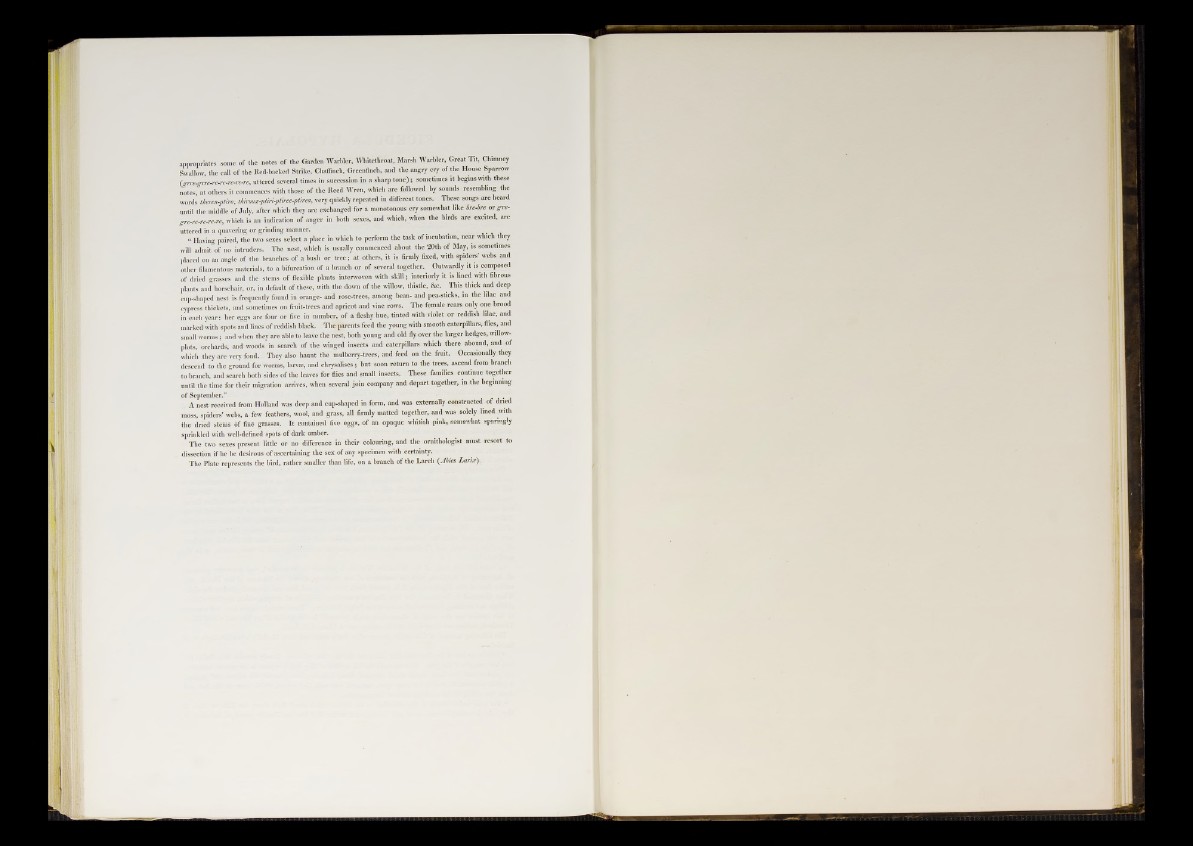
appropriates some of the notes of tl.e Garden Warbler, Whitethroat, Marsh Warbler, Great Tit, Chimney
Swallow, the call of the Bed-backed Strike, Chaffinch, Greenfinch, and the angry cry of the House Sparrow
(grre-grre-re-rc-re-re-re, uttered several times in succession in a sharp to n e ); sometimes it begins with these
notes, at others it commences with those of the Beed Wren, which are followed by sounds resembling the
words tkmn-ptiro, thirmix-ptiri-ptiree-ptirea, very quickly repeated in different tones. These songs are heard
until the middle of July, after which they are exchanged for a monotonous cry somewhat like breJtre or gre-
gre-re-re-re-re, which is an indication of anger in both sexes, and which, when the birds are excited, are
uttered in a quavering or grinding manner. ^
“ Having paired, the two sexes select a place in which to perform the task of incubation, near which they
will admit of no intruders. The nest, which is usually commenced about the 20th of May, is sometimes
placed on an angle of the branches of a bush or tre e ; at others, it is firmly fixed, with spiders’ webs and
other filamentous materials, to a bifurcation of a branch or of several together. Outwardly it is composed
of dried grasses and the stems of flexible plants interwoven with skill s interiorly it is lined with fibrous
plants and horsehair, or, in default of these, with the down of the willow, thistle, &c. This thick and deep
cup-shaped nest is frequently found in orange- and rose-trees, among bean- and pea-sticks, in the lilac and
cypress thickets, and sometimes on fruit-trees and apricot and vine rows. The female rears only one brood
in each year: her eggs are four or five in number, of a fleshy hue, tinted with violet or reddish lilac, and
marked with spots and lines of reddish black. The parents feed the young with smooth caterpillars, flies, and
small worms; and when they are able to leave the nest, both young and old fly over the larger hedges, willow-
plots, orchards, and woods in search of the winged insects and caterpillars which there abound, and of
which they are very fond. They also haunt the mulberry-trees, and feed on the fruit. Occasionally they
descend to the ground for worms, larval, and chrysalises; but soon return to the trees, ascend from branch
to branch, and search both sides of the leaves for flies and small insects. These families continue together
until the time for their migration arrives, when several join company and depart together, in the beginning
of September.” - . .
A nest received from Holland was deep and cup-shaped in form, and was externally constructed of dried
moss, spiders’ webs, a few feathers, wool, and grass, all firmly matted together, and was solely lined with
the dried stems o f fine grasses. I t contained five eggs, of an opaque whitish pink, somewhat sparingly
sprinkled with well-defined spots of dark umber.
The two sexes present little or no difference in their colouring, and the ornithologist must resort to
dissection if he be desirous of ascertaining the sex of any specimen with certainty.
The Plate represents the bird, rather smaller than life, on a branch of the Larch (Abies L a n x ).